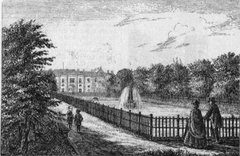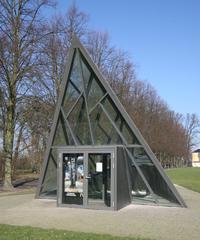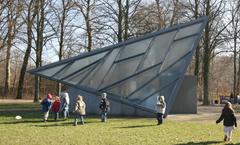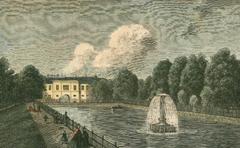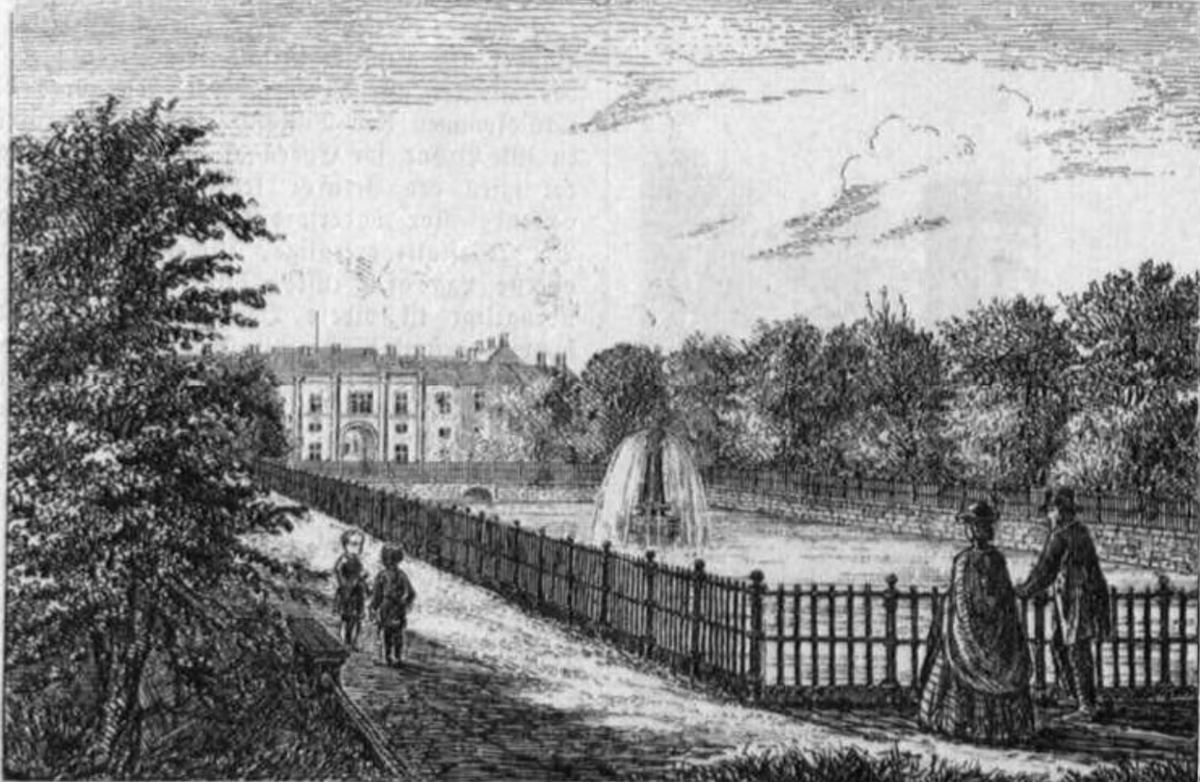
Cisternerne Copenhagen: Visiting Hours, Tickets, and Complete Historical Site Guide
Date: 14/06/2025
Introduction to Cisternerne: Copenhagen’s Underground Cultural Landmark
Beneath the green expanse of Søndermarken Park in Frederiksberg, Copenhagen, lies Cisternerne—a striking example of 19th-century engineering transformed into a contemporary art venue. Originally constructed between 1856 and 1859 as a vast subterranean water reservoir, Cisternerne once supplied clean water to a rapidly growing city. Today, it invites visitors into an atmospheric world of vaulted chambers, natural dripstone formations, and innovative art installations, exemplifying Copenhagen’s approach to sustainability and adaptive reuse.
Whether you are interested in history, art, or architecture, this guide provides everything you need to plan your visit, including opening hours, ticketing details, accessibility, nearby attractions, and tips for making the most of your experience. For up-to-date information, visit the official Frederiksberg Museums website and VisitCopenhagen’s Cisternerne page.
Contents
- Introduction
- History and Transformation
- Architectural Highlights
- Visiting Information
- Accessibility & Visitor Tips
- Cultural Significance & Exhibitions
- Nearby Attractions
- Frequently Asked Questions (FAQs)
- Conclusion
- Sources
History and Transformation
Construction and Early Purpose
Built from 1856 to 1859, Cisternerne was designed to address Copenhagen’s urgent need for a reliable water supply as the city expanded. The reservoir, ingeniously constructed beneath Frederiksberg Hill, could hold up to 16 million liters of water—an essential resource for public health and urban development. Its proximity to Frederiksberg Palace and Gardens allowed it to double as an ornamental reflection pool, merging utility and aesthetics (Frederiksbergmuseerne).
Decline and Cultural Rebirth
Advancements in water technology led to Cisternerne’s decommissioning in 1933. The chambers were fully drained in 1981 and lay dormant until the 1990s. In 1996, as part of Copenhagen’s European City of Culture celebrations, the site was repurposed for cultural events. By 2001, it became a venue for glass art exhibitions, and since 2013, it has operated as part of Frederiksbergmuseerne, focusing on contemporary, site-specific art (VisitCopenhagen).
Architectural Highlights
Subterranean Design and Atmosphere
Visitors enter via two modern glass pyramids in Søndermarken Park, which provide a dramatic contrast to the reservoir’s historic architecture. Inside, the cathedral-like space features vaulted ceilings up to 4.2 meters high, granite-block walls, and a labyrinth of tunnels totaling over 4,400 square meters. Over decades, water seepage has formed Denmark’s only true dripstone cave, with stalactites and stalagmites marking nature’s slow reclamation of the built environment (Cisternerne Facts).
Climate and Sensory Experience
The underground environment maintains near-100% humidity and a constant temperature between 8–16°C (47–61°F), with rare peaks up to 19°C. The thick, damp air, echoing acoustics, and dim lighting create an immersive atmosphere that has inspired artists to create unique, site-specific installations. The lack of mobile signal below ground further enhances the sense of otherworldliness.
Adaptive Reuse for Contemporary Art
Cisternerne’s annual exhibitions are tailored to its unique conditions, often engaging the darkness, humidity, and acoustics. Notable shows have transformed the chambers into immersive environments—like Tomás Saraceno’s “Event Horizon,” where visitors navigated a dark, water-filled space by boat, and Jakob Kudsk Steensen’s 2025 “Psychosphere,” inspired by underwater volcanic vents and ecological interconnectedness (Jakob Kudsk Steensen: Psychosphere).
Visiting Information
Opening Hours (2025)
- Season: Mid-March to November 30th
- Tuesday–Wednesday, Friday–Sunday: 11:00–18:00
- Thursday: 11:00–20:00
- Monday: Closed
- Always check the official website for up-to-date hours, as they may vary during exhibition changeovers.
Tickets and Admission
- Adults: DKK 120
- Students: DKK 90
- Children and teens under 18: Free
- Frederiksberg Museum Pass: DKK 180 (includes entry to Cisternerne, Bakkehuset, STORM, and Møstings)
- Group/school visits: Advance booking required
- Tickets are available online and are valid for one year from purchase.
Getting There
- Location: Søndermarken Park, Roskildevej 25A, 2000 Frederiksberg, Copenhagen
- Metro: M1 or M2 to Frederiksberg Station, ~10-minute walk
- Bus: Lines 9A and 350S stop nearby
- Parking: Limited street parking available; public transport is recommended
- Toilets: Public toilets are in Søndermarken Park, 200 meters from the entrance
Accessibility & Visitor Tips
Physical Accessibility
Due to its historic and subterranean structure, Cisternerne is not wheelchair accessible; access requires descending stairs. Strollers are not permitted inside but can be parked near the entrance. Guide dogs and accredited service animals are allowed (Frederiksbergmuseerne).
Sensory and Family Considerations
The dark, damp, and echoing environment may be daunting for people with sensory sensitivities or young children. Supervise children closely, and move slowly to adjust to the dim light and uneven floors. No food or drink allowed inside; plan to use nearby restrooms before your visit.
What to Bring and Wear
- Dress warmly: The chambers remain cool year-round, even in summer.
- Footwear: Wear sturdy, waterproof shoes with good grip.
- Photography: Allowed without flash or tripods; respect the art and ambiance.
- No mobile signal: Arrange meeting points above ground if visiting in a group.
Visit Duration
Most visits last between 45 and 90 minutes, depending on your interest in exhibitions and guided tours.
Cultural Significance & Exhibitions
Site-Specific Contemporary Art
Cisternerne commissions new exhibitions annually, inviting internationally recognized artists to create works that respond to the underground setting. Installations explore themes of nature, history, and sensory perception—leveraging the space’s climate, acoustics, and natural formations. The 2025 exhibition, “Psychosphere” by Jakob Kudsk Steensen, combines moving images, spatialized sound, and scientific research to explore ecological fragility (Jakob Kudsk Steensen: Psychosphere; Scandinavia Standard).
Events and Guided Tours
- Guided Tours: Offered on weekends and by appointment, providing in-depth insights into the site’s history and current exhibitions.
- Workshops/Family Programs: Special activities for children and families, especially during holidays.
- Special Performances: Concerts, readings, and artist talks take advantage of the unique acoustics.
Nearby Attractions
- Frederiksberg Palace and Gardens: Historic royal grounds adjacent to Cisternerne.
- Copenhagen Zoo: A popular family destination nearby.
- Bakkehuset Museum, STORM, and Møstings: Other Frederiksbergmuseerne venues worth exploring.
Frequently Asked Questions (FAQs)
Q: Is Cisternerne open year-round?
A: No, it is open from mid-March to late November.
Q: Can I buy tickets in person?
A: Yes, but online purchase is recommended, especially during peak times.
Q: Is Cisternerne wheelchair accessible?
A: No; the stairs and lack of lifts mean it is not accessible for wheelchairs or strollers.
Q: Can I take photos inside?
A: Yes, non-flash photography is allowed; tripods are not permitted.
Q: Are children allowed?
A: Yes, children under 18 enter free but must be supervised due to safety considerations.
Q: Are guided tours available?
A: Yes, check the official website for schedules.
Conclusion
Cisternerne is a testament to Copenhagen’s ability to blend historical preservation with modern artistic innovation. Its subterranean chambers provide a distinctive backdrop for exhibitions that challenge and inspire, while its history as a former reservoir offers a fascinating glimpse into the city’s evolution.
Plan your visit by checking current exhibitions and purchasing your tickets online. Dress warmly, respect the unique environment, and consider exploring other nearby Frederiksberg attractions. Enhance your experience with the Audiala app for guided audio tours and stay connected via social media for updates.
For further information and planning resources, refer to the official Frederiksberg Museums website, VisitCopenhagen, and the sources below.
